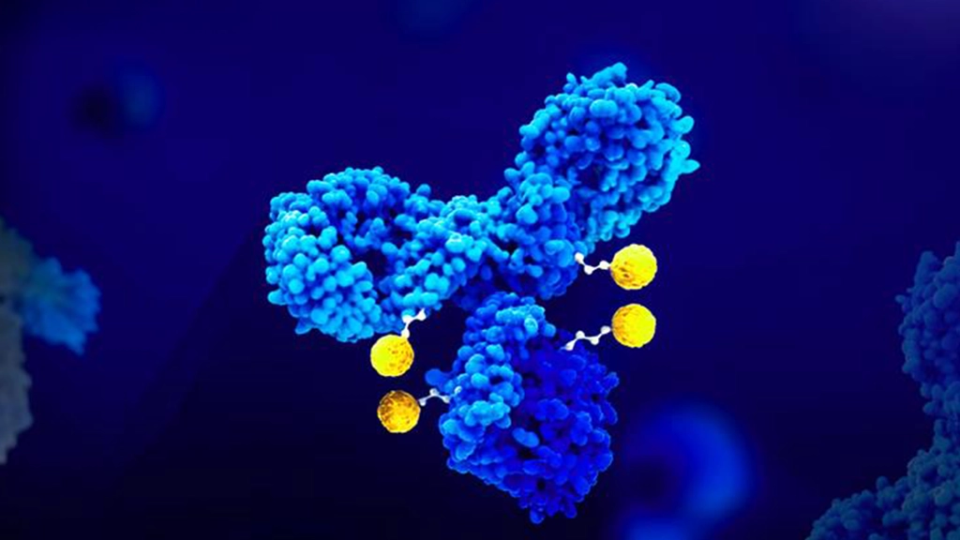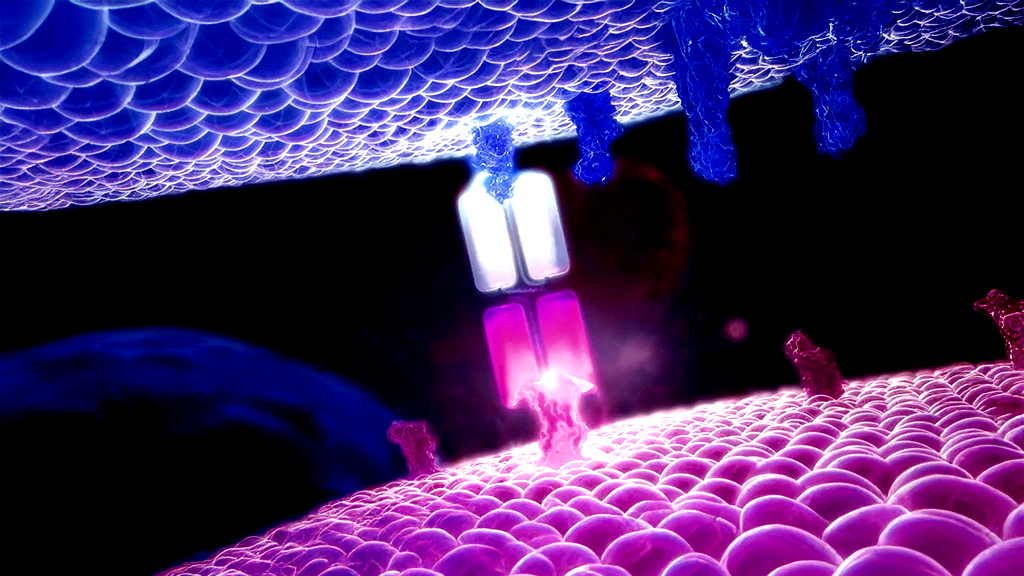In a world advancing towards precision oncology, cancer treatment evolves from blunt chemotherapy to a surgical-like precision at the molecular level. Imagine therapies that not only kill cancer cells but actively hunt, target, and dismantle them with unprecedented accuracy. That future is no longer theoretical. It’s happening now—through the revolutionary practice of Antibody drug Conjugates (ADCs).
What Are Antibody Drug Conjugates, and Why Is the World Watching?
At their core, antibody drug conjugates are sophisticated biopharmaceutical hybrid molecules that blend the unparalleled specificity of monoclonal antibodies (mAbs) with the toxic potency of chemotherapy to create a highly selective “search and destroy” mechanism for cancer therapy. Not only this, these conjugates enable the direct targeting of potent cytotoxins within cancer cells, resulting in minimal collateral damage and toxicity associated with traditional chemotherapy.
Similar to how logging into a secure login requires two-factor authentication via password and second code—verifying that it’s actually you; this molecule travels safely through the body, checks for the correct molecular signature on the cell surface, and then activates only upon proper authentication. That’s the level of precision antibody drug conjugates are striving toward—and increasingly achieving.
This three-part construction consists of an antibody, a linker, and a payload, which, together, enable highly selective targeting. In the process, ADCs become potent drugs that target & destroy cancer cells without injuring normal tissues.
Clinical ADC Breakthroughs Revolutionized Cancer Treatment
Let us bring the science into practice with a few examples already transforming treatment paradigms:
- Trastuzumab Deruxtecan (HER2+) is in the news for all the right reasons. With a remarkable survival rate of 79.7% in patients with HER2-positive breast cancer, it leaves traditional HER2 therapy in the dust. However, the real wonder of this innovation lies in its effectiveness in HER2-low tumors—a group previously considered untreatable by targeted means.
- Sacituzumab Govitecan (TROP2+) has emerged as a breakthrough in the treatment of triple-negative breast cancer (mTNBC) treatment. mTNBC is a disease known for its aggressiveness and resistance to chemotherapy, but historically without the benefit of targeted therapies. This new treatment, against TROP2, has delivered a staggering 5.6-month prolongation of progression-free survival. And, most notably, is its efficacy in heavily pre-treated patients, providing a lifeline rescue therapy for those who have nearly exhausted their options.
- Enfortumab Vedotin, or Nectin-4, is a powerful partner in the battle against urothelial carcinoma, and its real strength lies in combination. With checkpoint inhibitors, it has demonstrated an impressive ability to double overall survival rates. This combination marks a new dawn in cancer therapy, establishing a synergy between antibody drug conjugates and immunotherapy—one primes the target while the other delivers the knockout blow.
- Disitamab Vedotin (HER2-low) has been a game-changer in a field where HER2-low tumors once were marginalized, not meeting the high-expression threshold for HER2-targeted therapy and not responding to other therapeutic forms. The unparalleled efficacy of Disitamab Vedotin not only redefines the term “HER2-positive,” but also broadens the treatment landscape to encompass a formerly disenfranchised group of patients.
Each breakthrough brings us closer to a world where cancer therapy transcends simple targeting and becomes highly personalized. A future where no patient is left behind simply because their biology didn’t fit the mold.
Advances in Technology Offering ADC Therapy a New Boost
Antibody drug conjugates are keeping pace with the diseases they’re being designed to cure. Their strength is in both the molecular construct and the potential for customization. Let’s look at what’s breaking the mold:
- PEGylation: ADC manufacturers add polyethylene glycol chains to these molecules to enhance their pharmacokinetics, i.e., prolong half-life, solubilize, and decrease immunogenicity. This translates into longer circulation time and less frequent injection in the patient, which results in enhanced convenience and compliance—particularly in outpatient oncology practice.
- Dual Payloads: A few of the newer antibody drug conjugates combine two different cytotoxic agents into one construct. The dual strategy addresses the issue of tumor heterogeneity and drug resistance by targeting cancer through multiple biochemical mechanisms. With payloads having orthogonal mechanisms, developers can target the proliferative and dormant cell populations within a tumor.
- Photo-Activated Linkers: A new area in ADC design. These linkers trigger the release of the payload when exposed to light of a defined wavelength, allowing for laser-targeted activation at the target site with minimal systemic exposure. This idea introduces a completely new modality of antibody drug conjugate delivery—one that is spatially regulated and offers an additional level of personalization.
Together, these technologies are transforming antibody drug conjugates into modular treatment platforms that can adapt, personalize, and evolve.
R&D Momentum in the Antibody Drug Conjugates Innovation Landscape
The antibody drug conjugate space is experiencing explosive momentum—and it’s not just about molecules. It’s about ecosystems.
- Over 400 ADC candidates are being actively developed globally, many of which are targeting difficult-to-treat cancers like pancreatic, ovarian, and glioblastoma.
- More than 24 candidates are already in Phase III trials—demonstrating the maturity and potential of these pipelines to meet regulatory scrutiny and real-world application.
- Most antibody drug conjugates today are built on validated biological mechanisms but are being improved with newer linkers, smarter payloads, better tumor targeting, and enhanced control over pharmacokinetics.
This global IP scramble reflects more than just innovation—it signals a strategic bet by pharma companies and countries alike to dominate the next frontier of oncology. It’s not just about having a molecule—it’s about having a defensible, scalable platform. IP leadership is emerging as a key indicator of innovation maturity.
Market Growth – ADCs Are Outpacing Oncology
The financial story is just as compelling:
- According to IeB healthtech experts, the global oncology drug market is expected to grow from $232 billion in 2024 to $520 billion by 2031, with a CAGR of 12.2%.
- But the Antibody drug conjugates market? It’s projected to expand phenomenally from $11.5 billion to $39.8 billion in the same period—delivering a CAGR of 19.4%.
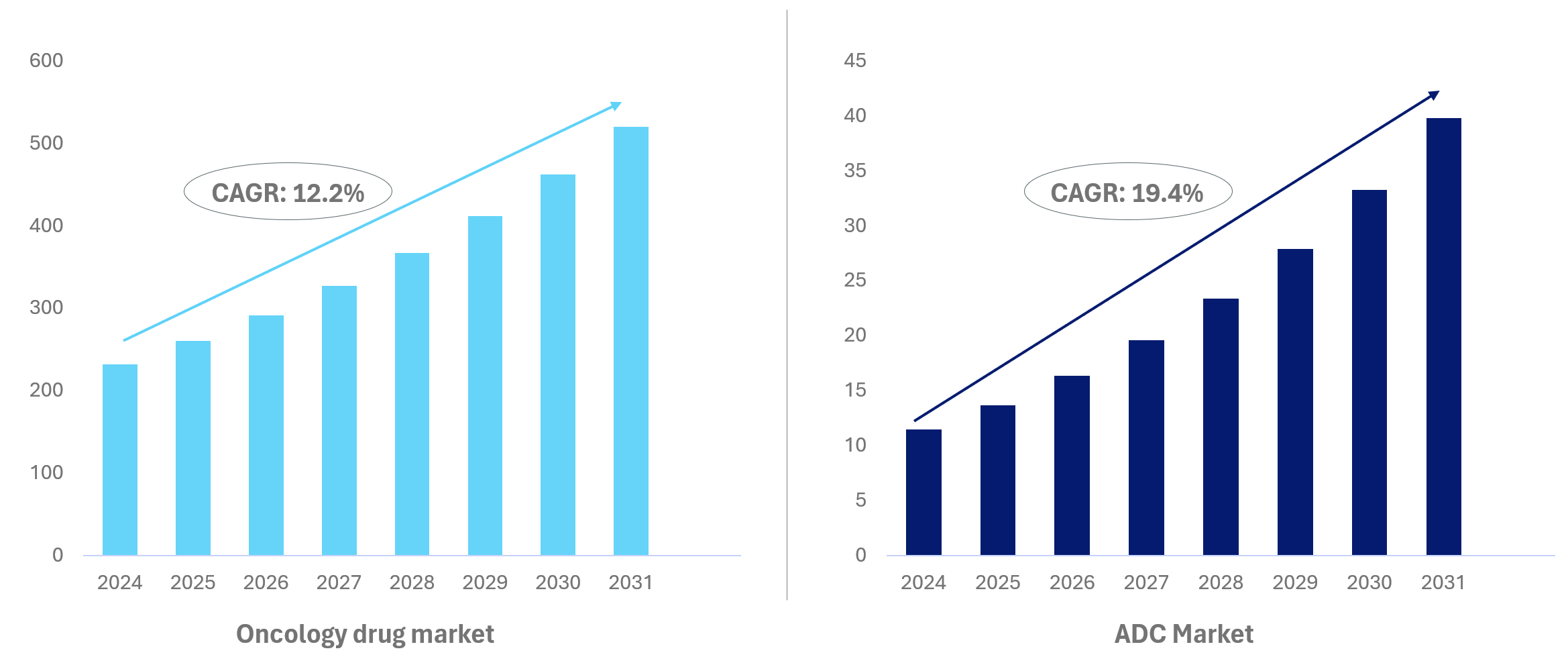
This explosive trend is a reflection of regulatory favor, clinical success, and investor enthusiasm. In addition, ADCs constitute an unusually value-rich space that is ready for mergers, acquisitions, and licensing deals. Major transactions in this space, including Pfizer’s significant acquisition of Seagen and Gilead’s sizeable $21 billion acquisition of Immunomedics, are a testament to the revolutionary effect ADCs are having on the strategic landscape of Big Pharma.
In an era defined by value-based care, antibody drug conjugates offer a potent combination of clinical performance and economic efficiency, particularly in terms of fewer side-effect management issues and the possibility of outpatient administration.
How Strategic Pharma Collaborations Are Igniting the ADC Competitive Landscape?
The antibody drug conjugate race is no longer a sprint—it’s an international arms race. Major pharmaceutical players are doubling down on internal R&D and actively reshaping the competitive landscape through billion-dollar mergers, acquisitions, and cross-border collaborations.
- AstraZeneca + Daiichi Sankyo: With Trastuzumab Deruxtecan and Datopotamab Deruxtecan, this partnership has carved out leadership in HER2-low and TROP2+ domains. Their synergy combines AstraZeneca’s global commercial reach with Daiichi’s deep expertise in ADCs, creating a pipeline powerhouse.
- Gilead + Immunomedics: Gilead’s $21 billion acquisition of Immunomedics brought Sacituzumab Govitecan into its arsenal. This bold move signaled Gilead’s serious pivot from antivirals into oncology.
- Pfizer + Seagen: With Seagen’s extensive IP and clinical-stage ADCs, Pfizer now owns a robust platform that integrates antibody drug conjugates with its immuno-oncology assets. This move enhances pipeline depth while strategically blocking competitors.
- Roche: A legacy leader in oncology, Roche has long invested in ADCs, including Kadcyla (ado-trastuzumab emtansine). The company continues to refine newer assets with improved tumor targeting, payload chemistry, and linker stability.
Based on the competitors’ market activities, ADCs are becoming foundational, not supplemental, in long-term oncology strategies.
Global Patent Landscape – Intellectual Property as a Competitive Weapon
Patents in ADCs go far beyond molecules. They cover linkers, payload chemistries, target antigens, manufacturing processes, and even novel delivery formats.
Global Filing Trends (2000–2023)
A review of 6,649 ADC-related patent applications across major offices reveals:

With a CAGR of 15.3%, the patent filings have grown exponentially—from 38 in 2002 to 719 in 2021. Multi-jurisdictional filings (across three or more regions) rose at a similar pace—underscoring the global nature of this innovation race.
Top Players in ADC Patent Landscape
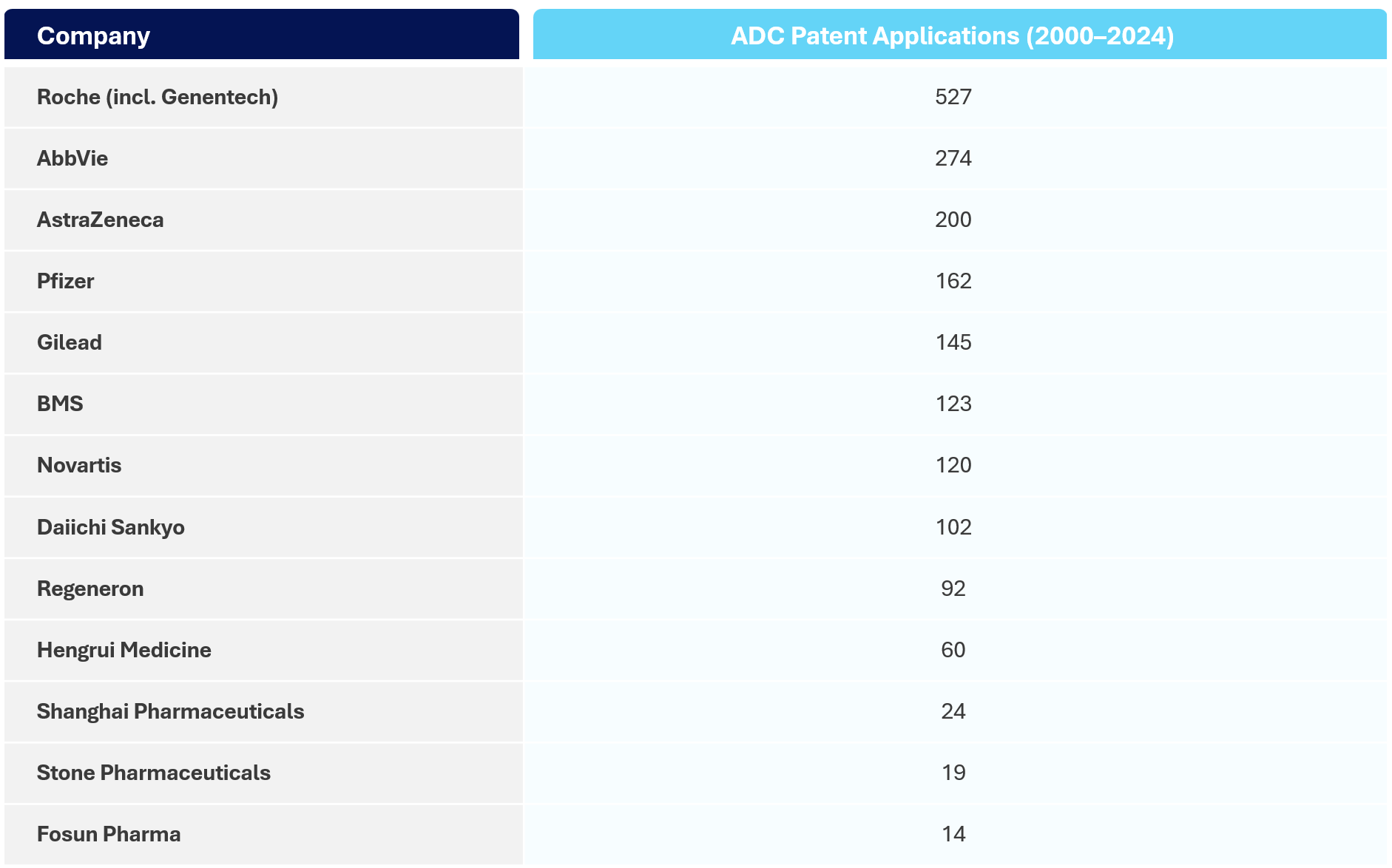
Key Pharma Players Dominating the Evolving Antibody Drug Conjugates Landscape
Regeneron Pharmaceuticals
Regeneron is applying its high-throughput R&D prowess to explore a diverse payload-linker-antibody toolbox within ADCs. Their patent portfolio reflects:
- Verrucarin A and Rifamycin analogs – Less conventional payloads with novel mechanisms, indicating a push toward non-standard cytotoxins.
- Cyclodextrin-based conjugates – A creative formulation angle that could improve drug solubility, stability, or site-specific activation.
- Anti-MUC16 ADCs – Targeting ovarian and pancreatic cancers, which express this biomarker prominently.
They’re also experimenting with formulation-based innovations, hinting at Regeneron’s attempt to fine-tune the delivery vehicle, thereby showcasing a broad innovation strategy.
Seagen Inc.
Over the past 20 years, Seagen has filed 167 patents, of which it holds 91 patents in the field of ADC therapy. With over half their patent activity concentrated in ADCs, they are laser-focused on refining every element of this therapeutic class. Their patents highlight:
- B7-H4-targeting ADCs – A promising tumor-associated antigen, especially in ovarian and endometrial cancers.
- Immune response modulators – Including anti-PD-1 and anti-CD30 combo constructs, which are likely aimed at enhancing T-cell activity in tandem with ADC efficacy.
- β-glucuronidase-linker-drug conjugates – Indicating innovative linker systems that enable selective, intracellular payload release—an elegant solution to improve therapeutic index and reduce off-target toxicity.
- Hydrophilic ADCs – These designs focus on optimizing pharmacokinetics by improving solubility and reducing aggregation, enhancing circulation time and tumor penetration.
Seagen’s IP suggests cutting-edge refinement of ADC architecture, particularly in areas such as linker chemistry, immune modulation, and tumor-selective delivery.
Key Innovation Pillars & Robust Strategies of Pharma Leaders
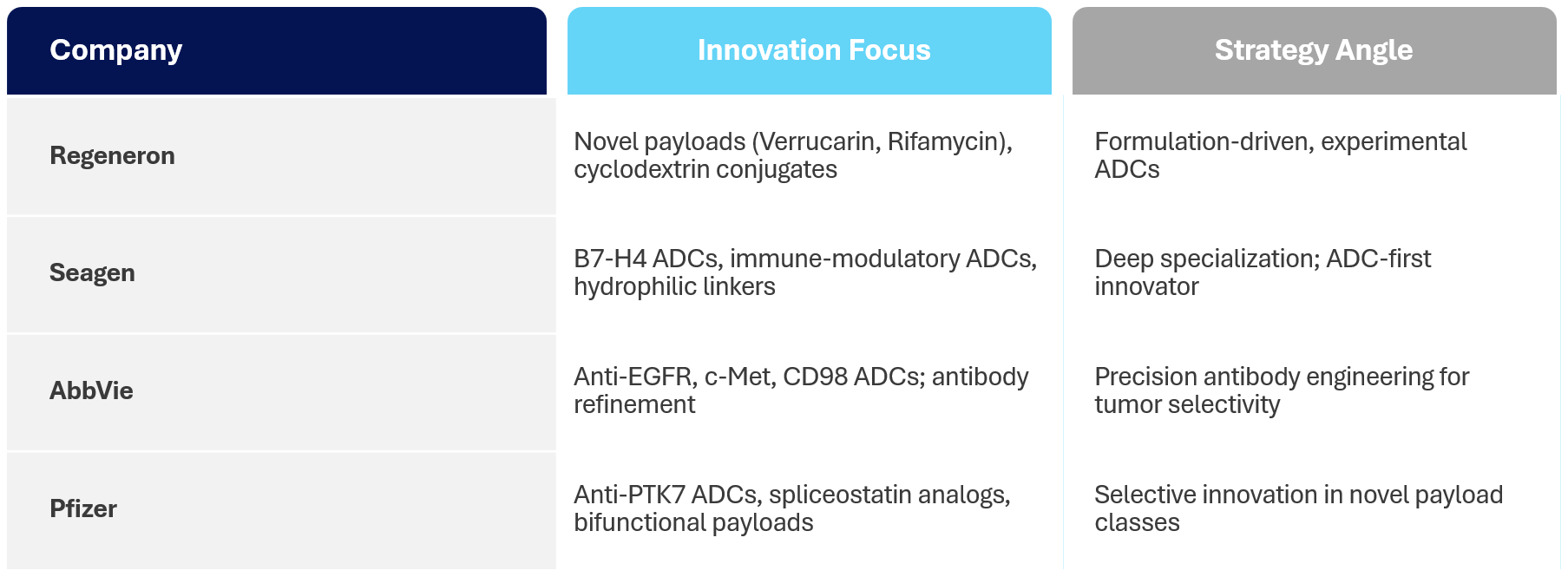
Fig: Strategic Innovation Pillars and Execution Frameworks Powering Competitive Differentiation and Market Leadership Among Global Pharmaceutical Giants
AbbVie
AbbVie’s patent strategy focuses on precision targeting through enhanced antibody engineering. Their portfolio shows strong attention to:
- Anti-EGFR ADCs and anti-c-Met ADCs – Indicating a dual focus on oncogenic receptor targets prevalent in solid tumors.
- Anti-CD98 ADCs – A more recent target with emerging validation, suggesting a forward-looking target portfolio.
- Multiple anti-c-Met variations – Reinforcing a deep investment in fine-tuning for tumor specificity and reduced off-target activity.
AbbVie is advancing antibody innovation with a strong emphasis on enhancing specificity, internalization efficiency, and payload precision—key elements aligned with next-generation ADC design principles that aim to maximize target affinity and minimize systemic toxicity.
Pfizer
Pfizer balances a massive R&D portfolio with a targeted effort in ADCs. While not hyper-concentrated in ADCs, their recent patents highlight innovation in:
- Anti-PTK7 ADCs – An emerging biomarker with promise in various epithelial cancers.
- Bifunctional cytotoxic agents – Possibly involving dual mechanisms (e.g., DNA damage + mitotic arrest), expanding therapeutic breadth.
- Spliceostatin analogs – Representing a novel payload class, targeting RNA splicing machinery—a bold direction compared to traditional tubulin/DNA payloads.
Pfizer isn’t flooding the ADC field—but it’s placing calculated, high-impact bets. Its investments in platform technologies, such as cytotoxic peptide-antibody conjugates and novel linkers, signal a strategic focus on next-generation payloads and multifunctional ADCs that bridge oncology with RNA science.
Regulatory Landscape – Global Attitudes Toward ADC Innovation
Each region is writing its chapter in the ADC story. While science drives the pipeline, regulation determines access.
- United States (FDA): Highly supportive of ADCs. The FDA frequently grants Breakthrough Therapy and Fast Track designations. Trastuzumab Deruxtecan and Sacituzumab Govitecan were both greenlit swiftly, setting regulatory precedents.
- Europe (EMA): Cautiously optimistic. The EMA emphasizes rigorous safety profiling, particularly around off-tumor effects and long-term cytotoxicity. It is keen on better post-marketing surveillance.
- China (NMPA): A rising star. China has embraced ADCs with accelerated IP filings, expanded clinical trials, and expedited approvals. Local companies are catching up rapidly, especially in linker technology.
- Japan (PMDA): Fosters innovation via collaborative R&D and tech transfer. Japan has also been at the forefront of early ADC approvals and global licensing deals.
Each regulator reflects a different opportunity—whether it’s the FDA’s speed, EMA’s scientific rigor, China’s growth runway, or Japan’s partnership mindset.
The Next Frontier – ADCs Beyond Cancer
The antibody drug conjugates not only dominate the precision oncology sector but also hold potential to revolutionize drug delivery across various diseases.
1. Autoimmune Disorders
Multi-indication ADCs are now being developed for diseases such as rheumatoid arthritis, lupus, and IBS (inflammatory bowel disease). These aim to deliver payloads to rogue immune cells while sparing normal immune functions.
2. Neurological Applications
CNS-penetrating ADCs are being engineered to cross the blood-brain barrier. Applications include glioblastoma, Parkinson’s, and even Alzheimer’s—where targeted removal of pathological cells or proteins is essential.
3. Personalized Payloads
The future may see ADCs tailored to the individual patient’s genomic and proteomic tumor profile—delivering truly personalized medicine with unmatched accuracy.
The evolution of ADCs from oncology workhorses to multi-system delivery platforms is already underway. The more we understand about cell surface targets and intracellular trafficking, the more diseases ADCs can target.
Conclusion
Antibody drug conjugates are not just a therapeutic option—they are a new scientific discipline. They merge immunology, chemistry, and systems biology into a new drug modality capable of reshaping how we understand, treat, and ultimately cure complex diseases.
From reshaping clinical outcomes to rewriting business strategy, ADCs are here to stay. The next wave of competition, collaboration, and cure will be led by those who understand not just the molecules—but the momentum behind them.
Partner with Ingenious e-Brain to navigate the ADC revolution. From patent landscaping to R&D acceleration, we help clients decode the future and make it actionable today. Fill out the form below or email us at contact@iebrain.com to speak with our industry experts and discuss strategies and impactful business approaches.

